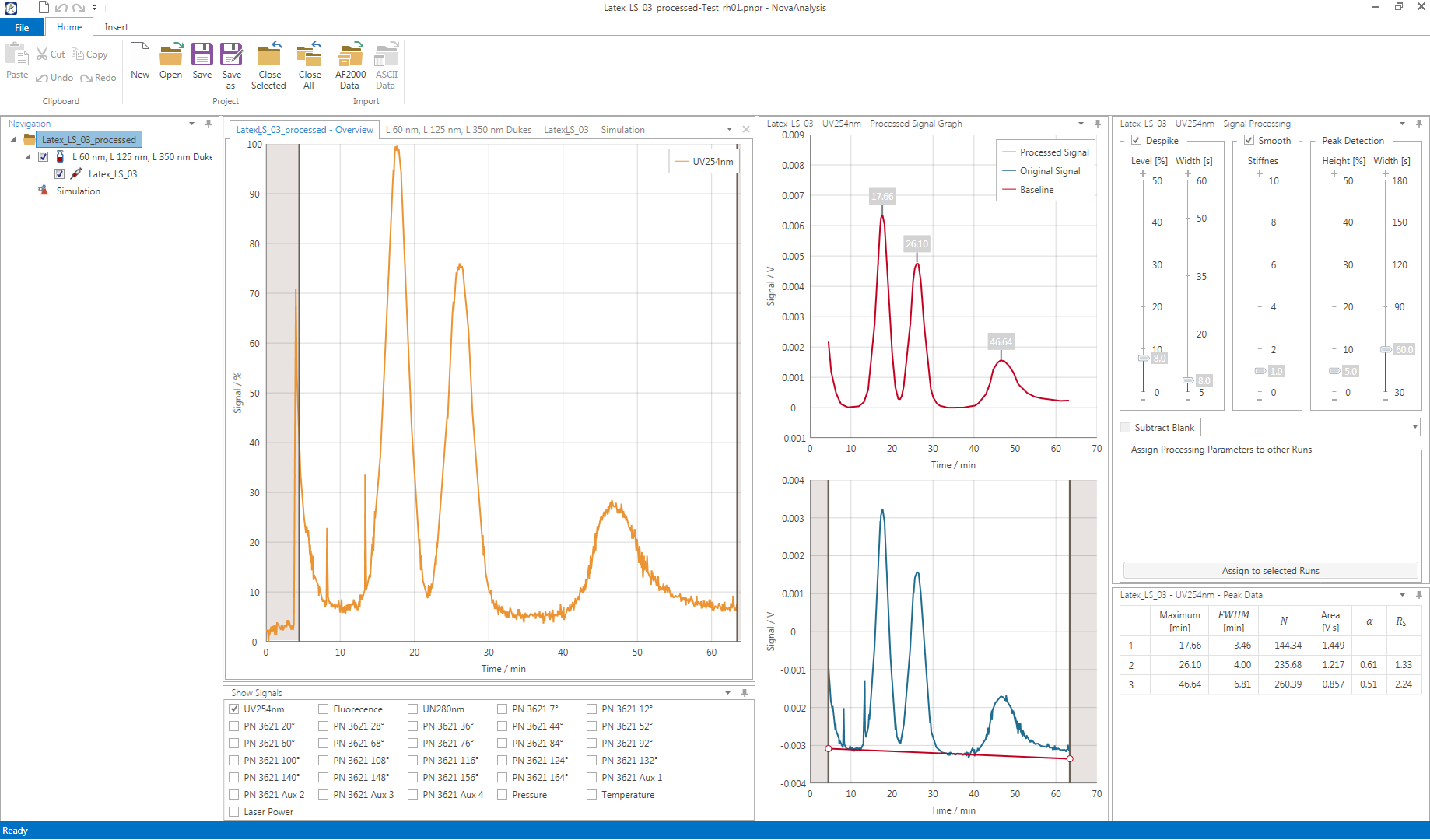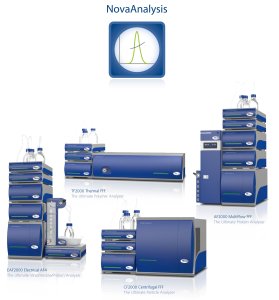Overview
NovaAnalysis Software
Field-Flow Fractionation (FFF) is a very powerful and adaptable separation technology that provides excellent results even in difficult applications. Since the performance is highly dependent on the selected instrument flow profiles, often several test measurements are necessary to develop the best method for an unknown sample. Optimization via simulation helps our FFF users to save instrument time and sample in finding optimum separation parameters.
NovaAnalysis is a new and dynamic evaluation software package with integrated method simulation based on published FFF theory. The NovaAnalysis software has been developed based on the theoretical work of Prof. Giddings, who invented the technique, and the many years of continuous research and development since. With its aid, the user can significantly reduce the time required for method development in FFF by running a series of virtual experiments. All method parameters such as channel flow, cross-flow profile, channel dimensions and focusing conditions can be varied and their effect on the results simulated and checked immediately. The resulting virtual method can be loaded into the AF4 or EAF4 instrument and used to make a real analytical run with the sample.
Features
Simulating an FFF Run
The software fully simulates separations on an advanced Postnova AF2000 (AF4), EAF2000 (EAF4), CF2000 (CF3) or TF2000 (TF3) system, including the ability to enter sample information and all possible dimensional variants of FFF channels and the corresponding flows. Any method parameter can be applied to virtual runs and compared with other sets of parameters. The simulation avoids performing multiple real fractionation runs and consuming sample material, and also reduces laboratory analysis time.
Optimizing FFF Methods
Advanced software features allow the optimization of FFF methods by simulating fractionation runs with different parameters to find the best combination of parameters to achieve optimal measurement results. After optimizing the method by simulation, a real fractionation can be performed by exporting the optimized method and then running it on the AF2000 or EAF2000 system.
EAF4 License
EAF4 allows a size-resolved determination of the electrophoretic mobility and zeta potential of components in complex mixtures. There are 3 calculation models selectable: Smoluchowski, Hückel and Debye length. Calculations are based on the effective E-field strength from conductivity at each shifted peak.
MALS License
MALS allows the calculation of the molar mass and size based on light scattering detection. Calculation methods are Zimm, Berry, Debye, Guinier-Approximation, Mie. Geometry models are sphere, hollow sphere, random coil, rod, and thin disk.
Ordering Information
P-NVA-FFF-005 NovaAnalysis Software Basic License incl. FFF Theory, Simulation, Evaluation, Reporting and Optimization
P-NVA-FFF-006 NovaAnalysis Software EAF4 Add-on License
P-NVA-FFF-008 NovaAnalysis Software MALS Add-on License
P-NVA-FFF-009 NovaAnalysis Software Viscometer Add-on License
P-NVA-FFF-010 NovaAnalysis Software 21 CFR part 11 Add-on License
NovaAnalysis

Specifications
Supported Operating Systems:
Windows 10 – 64 bit
Windows 11 – 64 bit (*)
(*recommended)
Hardware Requirements:
Intel® Core® i5 – 7500 (3.41 GHz) recommended Intel® Core® i7 – 7500 or better
16 GB RAM or more
Color Display min. 1920 x 1080
USB port for the software dongle
Security Certification:
SHA256/SHA1
Processing
• Signal alignments for multiple detectors
• Automatic baseline detection
• Automatic peak detection
• Despiking
• Smoothing
• UV scattering correction
Calibration
• Signal alignments
• Effective height
• Particle size (relative)
• Molar mass (relative)
• Quantitative with matching peaks
• Quantitative by direct injection
• Universal calibration
Calculation
• Particle size (Rh) from FFF theory and by relative calibration
• Molar mass and size distribution with cumulative and differential distributions
• Molar mass by relative an universal calibration
• Quantitative results by peak integration with calibrations
• Compositional analysis: Protein-conjugates, Copolymers
• Viral vector analysis and lipid nanoparticle analysis
• Cargo-Mass evaluation with CF3
• Mark-Houwink-Plot
• Branching analysis
• Electrophoretic mobility, zeta potential, net charge
• Patented EAF4 data evaluation for a true size-resolved electrophoretic mobility and zeta potential distribution
• MALS evaluations methods: Zimm, Berry, Debye, Guinier-Approximation, Mie
• MALS geometry models: sphere, hollow sphere, random coil, rod, thin disk
Import
• *.dat files with data and methods from NovaFFF software
• *.txt, *.csv files with data from external software as e.g. ICPMS
• Import of 21 CFR part 11 files
Report
• Fully integrated rich text editor
• One click to PDF-document or MS-Word *.docs file


